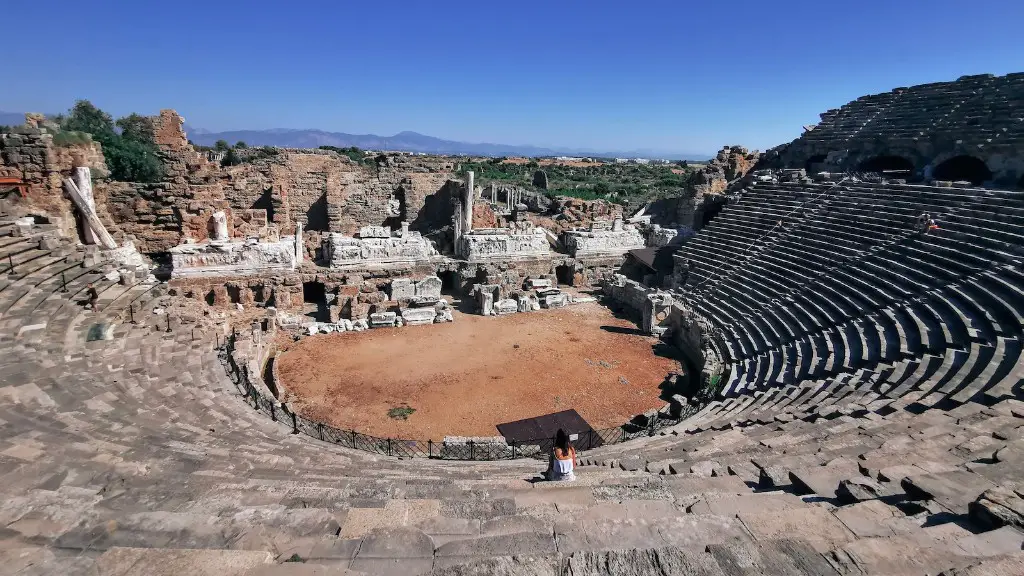In ancient Rome, childhood was a very different experience than it is today. The lifestyle and expectations for children changed significantly depending on their social class and gender. Education was highly valued and was provided differently for boys and girls. Romans believed that it was important for children to be educated to ensure the success of the Empire.
Upper-class boys were provided with the opportunity to receive a an education in rhetoric, philosophy, and Latin, depending on their father’s financial situation. Girls of the upper class were often taught reading, writing, and music by their mothers or hired tutors. Conversely, lower-class boys were typically taught a trade to become craftsmen and farm labourers, while lower-class girls learned domestic skills such as cooking and weaving.
However, the education that children received wasn’t limited to the classroom. Being outdoors and playing was also a major part of childhood. Many activities either had an educational or a militaristic aspect. Boys and girls alike engaged in running, archery, and hunting with wooden weapons like swords and spears. They also had games like ball, marbles, and hopscotch that we can still identify today. The main difference is that children were never allowed to wander too far from home or be out after dark.
Children were also expected to participate in religious activities alongside their parents. Boys may have had to perform ritual sacrifices, and girls were often taught the proper way to conduct themselves in the home and at religious events. Religion was a major part of life in Ancient Rome, and children were taught at an early age to honour and respect the gods. This affected their behaviour and the way they interacted with others in the community.
Roman children were also surrounded by violence, public executions, and battles. Family members and friends may have gone off to fight in wars, and death was a part of everyday life. This can be seen in Roman art, where scenes of death and destruction were often portrayed as scenes of entertainment. For this reason, children were not sheltered from the harsh realities of life, and were instead used to being exposed to violence from a young age.
Unlike our current society, Ancient Roman childhoods were much more structured and serious. Education and activities were mainly focused on the development of the individual and the welfare of the Empire. Although much has changed since then, there are still some aspects of Ancient Roman childhood that are echoed in modern day life.
Family dynamics
Family was very important to the Ancient Roman way of life, and there were clear roles within the family unit that children had to follow. Fathers were in charge of the family, while the mother ran the domestic part. Sons were expected to follow in their father’s footsteps, while daughters had to learn proper behaviour towards their father and other household members.
Family life revolved mainly around religious ceremonies and festivals, and children were expected to join in and repeat their prayers and respect the gods. Fathers had the right to sell their children if the children did not obey the rules of the household. This was a common punishment that was used to ensure that children respected and obeyed their parents.
Legal status
Legal status for children in Ancient Rome was also different compared to today. Children weren’t allowed to own property until they were 18 years old and were dependent on their parents until then. There was no such thing as formal adoption in Roman times, but children could be given away or sold in exchange for a dowry.
It was also common for parents to leave children at the temples in the event that they weren’t able to care for them. Those children would be taken in by the temple priests and provided with food, clothing, and education until they were old enough to be married. This was a common practice among the lower and middle classes.
Age of majority
In Ancient Rome, the age of majority for females was 12 and for males it was 14. Girls were usually allowed to be married at 12, although it was more common for marriages to occur at around 14 or 15. Boys weren’t allowed to marry until they reached the age of 18.
However, the age of majority had to do with more than just marriage. Roman law stated that boys were expected to reach financial independence at the age of 20 and girls at 18. After this, parents were no longer allowed to intervene in any legal dealings involving the children, and the children were considered citizens of Roman society.
Child labour
Child labour was also a common practice in Ancient Rome. Children were used as servants and labourers in domestic and agricultural work, as well as in trades such as weaving and manufacturing tools. Children were also required to perform military service in the event that their fathers were called up to fight in a war.
Child labour was a significant part of Roman society, and children were often treated harshly. They had long hours, were given very little food and rest, and were frequently punished for not meeting their masters’ expectations. This harsh treatment was due to the fact that children were seen as not having the same rights as adults and were therefore more expendable.
Recreation
Despite the serious nature of Ancient Roman childhood, there were still opportunities for leisure activities. Children were always welcome to join their parents for a walk in the nearby parks, and were often encouraged to participate in theatre, music, and dancing. Boys and girls were also given the opportunity to learn sports such as javelin throwing, wrestling, and racing.
Ancient Roman children were also encouraged to read and write, and the younger children were told stories and myths by the older children or their parents. Storytelling was an important part of Christian culture and a popular pastime in Roman times.
Conclusion
Ancient Roman childhood was much different to our current understanding of what childhood should be. Education and activities were mainly focused on preparing children for adulthood, and there was very little room for recreation or leisure. Parents played a very important role in the lives of their children, and children were expected to obey their parents’ authority and respect the gods. Despite being practiced in a very different context, there are still some aspects of Ancient Roman childhood that are echoed in modern day life.




